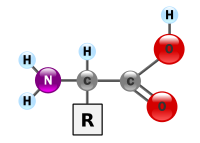
Photo from wikipedia
BACKGROUND Plant-based milk alternatives are becoming more popular. However, many are low in nutrients, particularly protein. More attention is being given to plant protein isolates/concentrates as potential ingredients in high-protein… Click to show full abstract
BACKGROUND Plant-based milk alternatives are becoming more popular. However, many are low in nutrients, particularly protein. More attention is being given to plant protein isolates/concentrates as potential ingredients in high-protein milk alternative formulations. RESULTS The effect of lupin protein source on the physicochemical, functional and nutritional characteristics of model milk alternatives was investigated. Milk alternatives were produced with either blue lupin or white lupin protein isolate, formulated to contain similar levels of protein and fat as low-fat cow's milk. Nutritional composition and predicted glycaemic properties were measured. Additionally, the effect of homogenisation pressure on the physicochemical properties and storage stability was assessed, with cow's milk and soy milk-alternative analysed for comparison. Both blue and white lupin milk alternatives were high in protein, low in fermentable oligo-, di- and monosaccharides, and polyols (FODMAPs) and had low predicted glycaemic index. White lupin milk alternatives had smaller particle size as well as greater stability, with less creaming compared to blue lupin milk alternatives, although the former showed slightly higher sediment layers. Increasing homogenisation pressure from 180 to 780 bar resulted in smaller particle size, lower separation rate, and greater foamability for both blue and white lupin milk alternatives. White lupin milk alternative homogenised at 780 bar was found to be the most stable product, with a similar separation rate to cow's milk. CONCLUSIONS These results indicate that protein source, as well as processing, can significantly influence functional properties along with product stability, and is an important consideration when formulating high-protein milk alternatives. This article is protected by copyright. All rights reserved.
Journal Title: Journal of the science of food and agriculture
Year Published: 2021
Link to full text (if available)
Share on Social Media: Sign Up to like & get
recommendations!